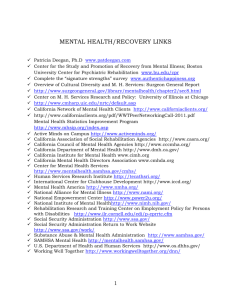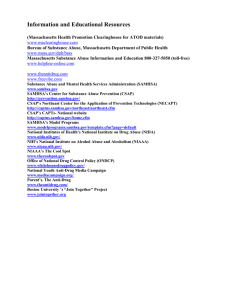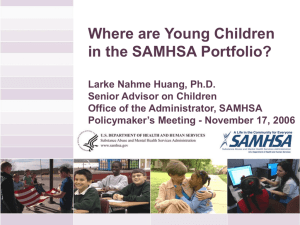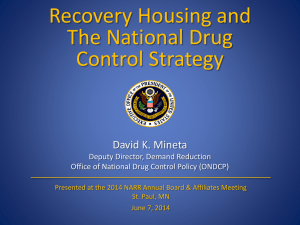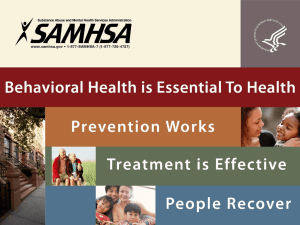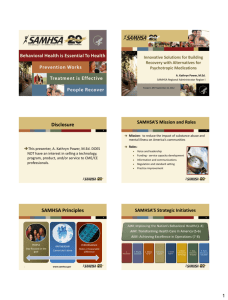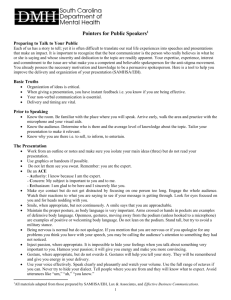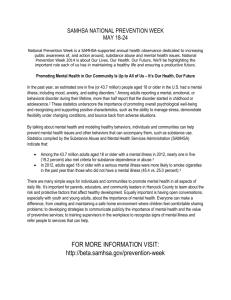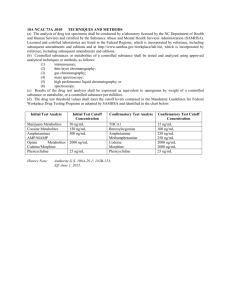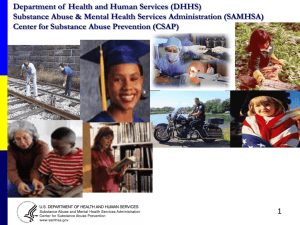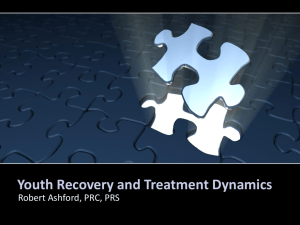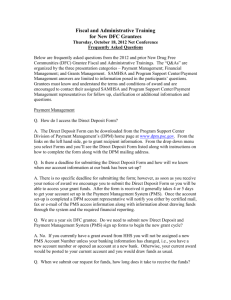Where are Young Children in the SAMHSA Portfolio?
advertisement
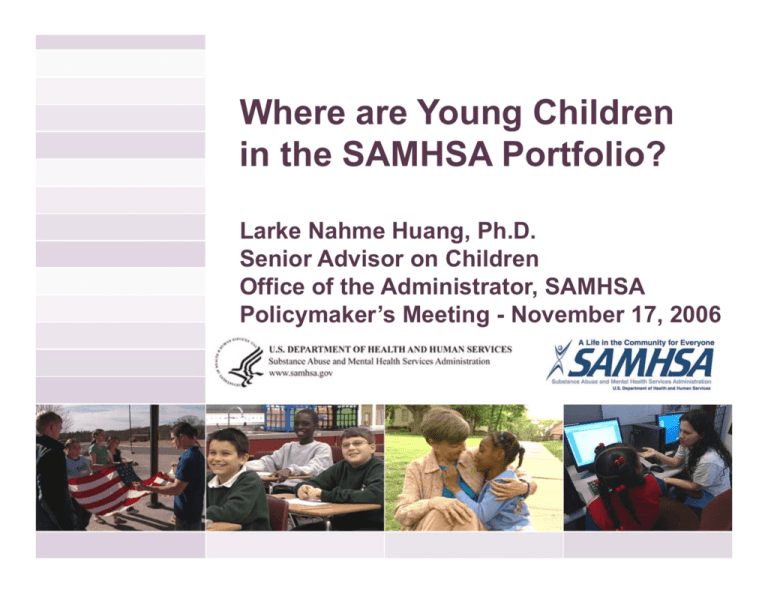
Where are Young Children in the SAMHSA Portfolio? Larke Nahme Huang, Ph.D. Senior Advisor on Children Office of the Administrator, SAMHSA Policymaker’s Meeting - November 17, 2006 SAMHSA ADMINISTRATOR (VACANT) DEPUTY ADMINISTRATOR (ACTING) Eric B. Broderick, D.D.S., M.P.H. OFFICE OF APPLIED STUDIES OFFICE OF POLICY PLANNING AND BUDGET OFFICE OF PROGRAM SERVICES ACTING DIRECTOR Anna Marsh, PH.D. DIRECTOR Daryl Kade ACTING DIRECTOR Elaine Parry . CENTER FOR MENTAL HEALTH SERVICES CENTER FOR SUBSTANCE ABUSE PREVENTION CENTER FOR SUBSTANCE ABUSE TREATMENT DIRECTOR A. Kathryn Power, M.ED. DIRECTOR (ACTING) Dennis O. Romero DIRECTOR H. Westley Clark, M.D., J.D., M.P.H Children & Families Matrix Work Group SAMHSA’s Vision i ffor allll children is hild and d youth th to t live li ffullll lilives iin the community - to have an education, preparation for employment, and meaningful relationships l ti hi with ith ffamily il and d ffriends. i d SAMHSA’s Mission is to improve outcomes for children and youth with and/or at risk for mental, substance use and/or co-occurring g disorders,, and their families by increasing access to a continuum of comprehensive, integrated, culturally and linguistically competent services and supports—that include prevention, early intervention, treatment, and recovery. SAMHSA’s Children and Families Workgroup Promotes Collaboration Across all 3 Centers to: •Fund Fund grants jointly across Centers (e.g., (e g Child and Adolescent State Infrastructure Grant). •Develop TA resources and activities (e.g., TA Inventory, strategies for linking mental health, substance use, and primary care); and •Collaborate with other Federal partners (e.g., Federal/National Partnership for Transforming Child & Family Mental Health & Substance Abuse Prevention & Treatment; Federal Partners Collaborative for Social & Emotional Development of Young Children Ages 0-5) Children and Families Matrix Work Group: Action Plan Strategic Action Item: Establish a national initiative to promote healthy development and resiliency of young children, reaching their parents/ caregivers earlier to prevent or reduce mental and/or substance use disorders. New Freedom Commission on Mental Health: 4.1: Promote the mental health of young children CF Work Group: Sub-committee on Young g Children Develop SAMHSA’s Plan for Young Children Coordinate efforts across 3 Centers Highlight importance of early years for SAMHSA staff 0-5 Collaborative of federal partners and 12 TA Centers focusing on 0-5 Federal consensus statement Sampling of SAMHSA 0-5 Efforts CMHS: System of Care – 6 Early childhood grants & Community of Practice Prevention & Early Intervention Æ 30% grantees serve infants; 62% serve 0-5 National Child Traumatic Stress NetworkÆ 44 of 53 centers serve 0-7 year olds Prevention/ Early Intervention Grant Program Age of Target Population N=23 High School (14-18 years old) 3% Middle School (12 13 years old) (12-13 5% Infants/Toddlers (0-3 years old) 30% Elementary School (6 11 years (6-11 ears old) 30% Preschool (4-5 years old) 32% Infants/Toddlers Preschool Elementary School Middle School High School 11 ggrantee programs g 12 grantee programs 11 grantee programs 2 grantee programs 1 grantee programs Sampling of SAMHSA 0-5 0 5 Efforts CSAP: “Building g Blocks for Healthy y Future” Caregivers of 3-6 yr olds, model healthy behaviors; 85,000 kits National Head Start Association/National Assoc of Elementary Schools Fetal Alcohol Spectrum Disorders Center for Excellence- resources, training, TA on prevention & services CSAT: Pregnant & Postpartum Women Substance Abuse Residential Treatment Programs for women with their children, mostly 0-7 year olds Directions to Consider Blending Initiatives - science to service; translating research on early child development, services and interventions Æ policy and practice Federal policy statement re 0-5 emphasize importance and commitment Develop family models of care Æ with supporting infrastructure (workforce, funding, etc.) Consider Consider cross cross-agency agency grant program on 0-5 Focus on trauma and young children “Spread “S d the th word” d” Æ dissemination di i ti & uptake Visit SAMHSA’s Children and Families Webpage p g for More Information: http://www.samhsa.gov/Matrix/matrix_families.aspx
